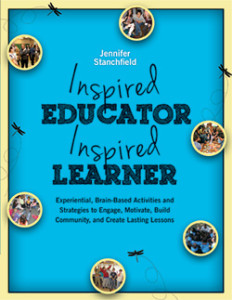
Mar 03, 2015 Create Multiple Pathways to Learning
Excerpt From: Inspired Educator, Inspired Learner: Experiential, Brain-Based Activities and Strategies to Engage, Motivate, Build Community and Create Lasting Lessons

The more senses that are used to learn and practice information, the more neural networks are activated and the more ways the brain is able to store and retrieve information. Neuroscientists emphasize that long-term memory storage requires spaced repetitions of input (Kandel, 2006 cited in Willis, 2013). Multiple strategies for learning and practicing information such as moving and talking, active reflection, art, and writing not only increase learners’ interest and attention but also create multiple pathways to learning. Sam Wang states, “Memories are reinforced and even transferred to other brain regions than the place where they are stored for the first time. This movability of memory means that memory can change with time—and be strengthened with repetition. Like I tell my students: cells that fire together, wire together” (personal communication, April 19th, 2014).
The more ways something is learned and practiced, the easier it is to recall and access that information. This book offers a number of experiential strategies for engaging learners in ways that use multiple senses to learn, practice, and reflect upon information to increase multiple pathways to learning.
Here is an example of one of my favorite activities that uses multiple senses to explore a topic or reflect on information learned:
 Graffiti Wall
Graffiti Wall
Purpose/Focus: active engagement, hook, emotional connection to content, “first five” or “do now,” transition, conversation starter, community building, empathy, discussion/writing prompt, reflection, collaboration, differentiation, multiple pathways to learning, creativity/imagination, group norms
Material: butcher or flip-chart paper, masking tape, markers, crayons, etc.
Kasey Errico shared with me that she and her colleagues use this activity to encourage creative thinking prior to staff meetings. I find this effective with teacher groups, students, and leadership programs for reflection, to initiate conversations about a subject, or to review material.
Facilitation Suggestions:
• Tape lengths of paper on the walls or a table top.
• As participants enter the room, hand them magic markers or crayons to represent a can of spray paint and ask them to imagine that they are graffiti artists who have been invited to express their thoughts on the topic at hand using words and symbols.
• As with graffiti, others may add to and/or comment on these musings.
• The activity can be done silently to increase focus.
• For longer courses or workshops, participants can add graffiti throughout their time together (see chapter nine).
Outcomes/Reflections:
I like the blend of self-reflection and group collaboration found with this activity. Often people will more readily express their thoughts through artwork than verbal means. It is non-intimidating to those who don’t consider themselves “artists” because they can blend words and images. Group members can choose their level of participation and learn as much from contributing as they do from observing other’s posts. The graffiti becomes an “artifact” of the group’s thoughts and experiences and can generate meaningful dialogue and reflection. Doing this silently (a challenge with middle-schoolers), increased the reflective aspect and focus during the activity. See chapter nine for specific examples of using this and other creative expression activities for reflection.
For complete bibliography/references and resources on the brain and learning see Inspired Educator, Inspired Learner Wood N Barnes Publishing Company.



No Comments